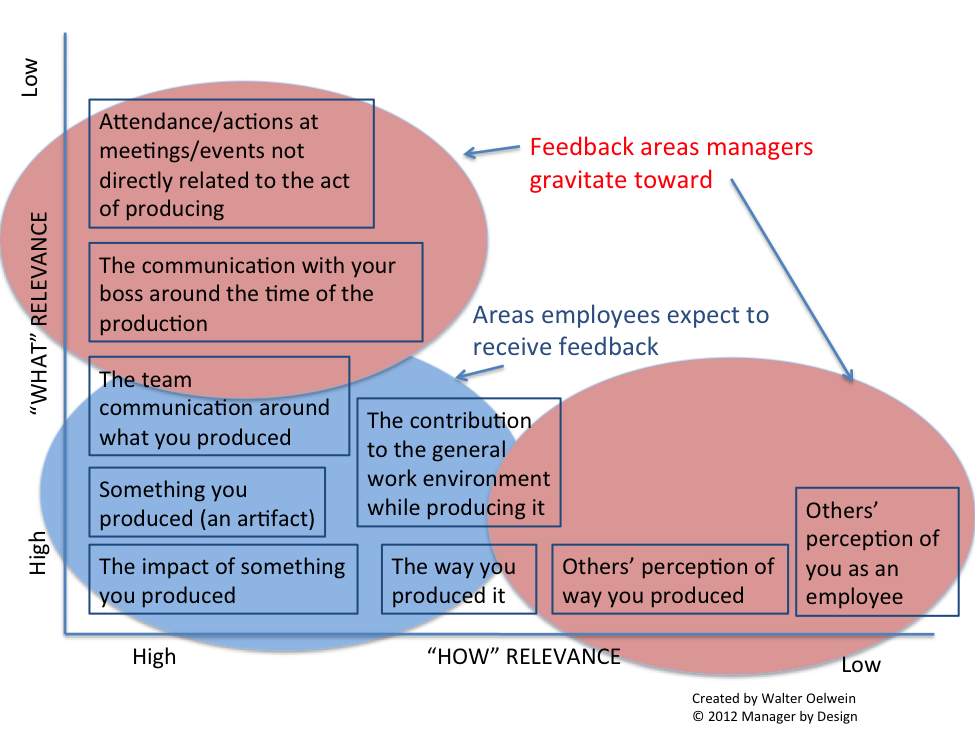A second phantom job many employees have: Managing perceptions of others
In my previous article, I shared a model to determine the relevance of the performance aspect of performance feedback that many managers give to employees. Here’s the model:
In looking at the upper left corner of this model, many managers create, via the act of giving performance feedback, a second job for the employee: How the employee performs in front of the boss.
So now the employee has two jobs: 1. The job and 2. The job of performing in front of your boss.
The model reveals also in the lower left corner that when a manager gives performance feedback, a third job is often created:
3. The job of managing the perception of others in how you perform your job.
Has a manager even given you “performance feedback” that says something to the effect of the following:
“Others say that you aren’t cutting it.”
“There’s a perception that you’re not pulling your weight.”
“There’s a perception that you don’t deliver on time.”
(Ignore for a moment that this feedback does not meet the standard of being “specific and immediate”.)
Note in these examples, the thing that needs to change is the perceptions of others first, and the job performance second. As a result, when receiving feedback that cites others and their perceptions, this creates a phantom third job for an employee. The employee is now obliged to perform:
1. The job
2. The performance in front of the manager
3. The creation of the impression of performance to others.
These two auxiliary jobs – or “phantom jobs” as I like to call them – create a lot more work for the employee. The moment the employee receives some feedback related to either of these two phantom jobs, the employee is more likely to stop doing the first job, and focus on resolving the second two.
The problem is that these second two jobs are ill-defined, and a lot of effort can go into improving the boss’s impression of the employee and the impression of what others think. The likelihood that the individual employee can change these impressions and perceptions is actually quite low. But the feedback requires that employee make this effort nonetheless.
Worse yet, there is likely no standard of performance for these two phantom jobs. When you “manage perceptions,” you are reliant on an unreliable source – “others” – that have intermittent reporting at best and are biased at worst. Then, when is this standard re-measured to see if there was improvement? The “perceptions” have probably moved on to other, new “perceptions” by “others.”
Managing perceptions is not only hard, it’s impossible and frustrating. And it takes away from the energy of doing the job itself.
Yet many managers seem highly focused on the “perceptions” that an employee creates, and start trying to help by providing feedback on these perceptions. This sends the employee in an impossible cycle of trying resolve something that is not able to be resolved.
How managers can reduce the second phantom job
Managers can actually help by stop worrying about and commenting on perceptions and instead start focusing on feedback related to the artifacts the employee’s job is expected to produce, and the actions taken (more info here and here) to create the artifacts. This makes the feedback more job-related, and if the job outputs are improved, the manager will be pleasantly surprised that “perceptions” are largely irrelevant and perhaps contradictory to what the employee is doing on the job.
Do you have a manager who likes to manage to perceptions? Has this made you better at what you do? Have you had a manager who willfully ignores perceptions and focuses on job output and the methods taken to produce that output? Which do you prefer?
Related Articles:
A tool for how to tell if feedback is relevant to your job
What inputs should a manager provide performance feedback on?
The Art of Providing Feedback: Make it Specific and Immediate
An example of giving specific and immediate feedback and a frightening look into the alternatives
What inputs should a manager provide performance feedback on?
When to provide performance feedback using direct observation: Practice sessions
When to provide performance feedback using direct observation: On the job
Areas of focus in providing performance feedback based on direct observation: Tangible artifacts
What managers can do about “intangible human-based artifacts”
Three reasons why giving performance feedback based on indirect information doesn’t work
Bonus! Six more reasons why giving performance feedback based on indirect information is risky
Tips for how managers should use indirect sources of information about employees
What to do when you receive a customer complaint about your employee’s performance
Telling someone they “don’t take feedback well” doesn’t count as performance feedback
Three more reasons “You don’t take feedback well” is risky performance feedback



